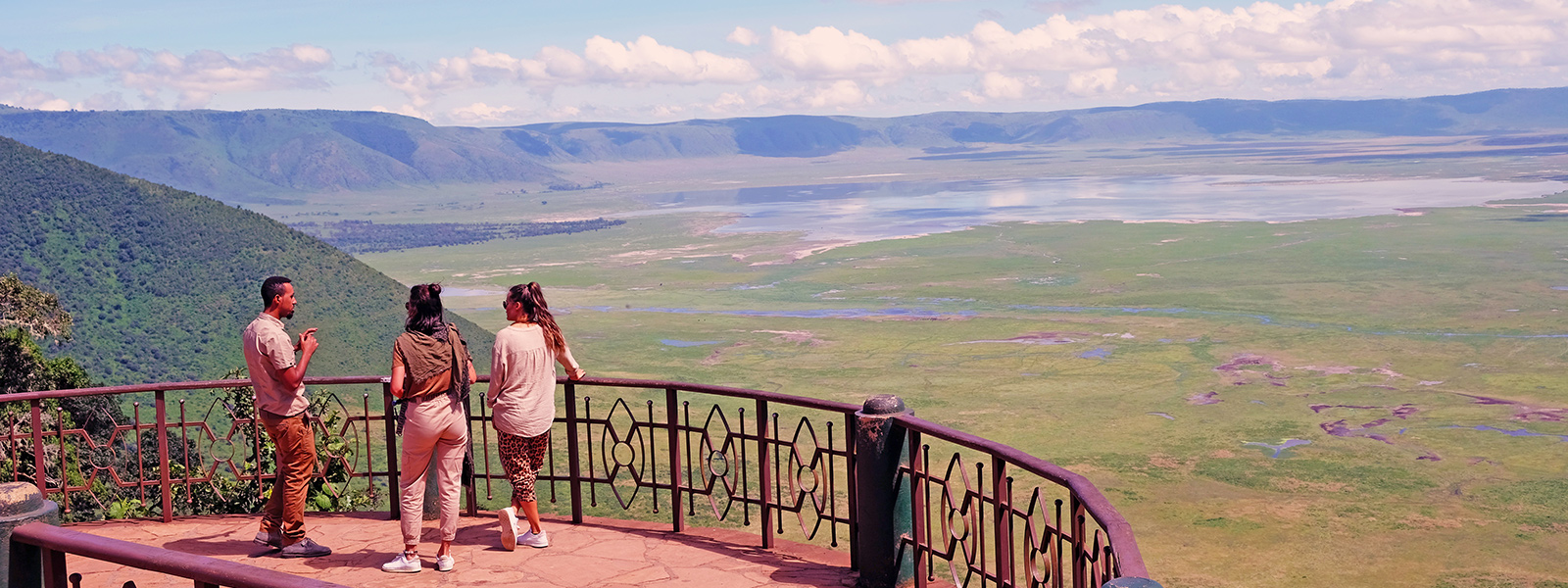
The Ngorongoro Conservation Area is a UNESCO World Heritage Site, and International Biosphere Reserve, covering almost 8,300 km2 with altitude ranging between 1,020m to 3,577m. Frequently referred to as the eighth wonder of the world, the area encompasses a blend of landscapes, archaeological sites, people and abundant wildlife that unsurpassed in Africa. Featuring volcanoes, grasslands, waterfalls and forest, it is home to the nomadic Masai.
The centerpiece, and major landmark, of the Conservation Area is the breath-taking Ngorongoro Crater, a natural amphitheater surrounded by steep walls rising over 600 meters from the crater floor. It is one of the world's greatest natural spectacles whose magical setting and plentful wildlife never fail to thrill. The crater is a natural sanctuary for almost 30,000 animals including the “Big Five” of buffalo, elephant, leopard, lion and rhino. It is also home for the cheetah, hartbeest, hippo, hyena, jackal, reedbuck, serval, warthog, waterbuck, wildbeest, zebra and a great many bird and insect species. Reedbuck, waterbuck and huge herds of both thomson's and Grant's gazelle are easily seen on the crater floor. Thanks to anti-poaching patrols, the crater is now one of the few places in East Africa where visitors can be certain of seeing black rhino.
Close to the Ngorongoro Crater there are two less famous, and less visited, craters ideal for walking and hiking safaris. Empakai Crater is about 6km wide with steep walls rising to almost 300m. Nearly half of the crater floor is covered by deep salt water lake. The trail down to the crater floor offers spectacular views of the still active volcanic mountain, Oldonyo Lengai, and on a clear day, the snowy peaks of Mount Kilimanjaro. On the way down to the lake you'll encounter buffaloes, bushbucks, blue monkeys and rare birds, such as sunbirds and turacos. Olmoti Craters' Floor is shallow and covered with grass where, in addition to the Maasai and their livestock, buffalo, eland and reedbuck may be seen. The Munge River crosses the Olmoti crater before falling hundreds of meters in a spectacular waterfall. Countless flamingos form a vast pink blanket over the soda lakes, while more than 100 species of birds not found in the Serengeti have been spotted here.
Olduvai Gorge is also an iconic site for the study of human origins. Located within the Ngorongoro Conservation Area, only a short drive off the main road between Ngorongoro and the Serengeti. It was here that, in 1959, Dr Louis Leakey and his wife Mary discovered the 1.7-million-year-old skull of Australopithecus boisei, the 'modern man', and , the remains of Homo Habilis or “Handy man” at that time regarded as mankind's first step up the ladder of human evolution. Many fossils have been discovered including those of prehistoric elephants, giant horned sheep and enormous ostriches. A new Museum has just opened, where visitors can listen to an informative talk. The project includes the Laetoli, which is 60km from Olduvai, is home to four-million-year-old footprints of human ancestors.
Tourist attractions includes: Game drive (Dense road network confined to the floor of the Ngorongoro Crater and Ndutu), Hiking with a guide (a good variety of trails. Treks of several days possible along the longer trails), Visit to the Maasai Cultural Boma, Visit to the Oldupai museum and archeological site, Balloon safaris, Photographing safaris, Camping, Bush meals.
Getting there
The Area is easily accessible, both by Good tarmac Road about 177km from the town of Arusha to the park HQ situated on the rim of the Ngorongoro crater, the first 150 km tamarc, the last 27 km dirt road, driving time 3h (official entry point at Lodoare Gate, where the tarmac ends), By air: Tour company can organize private flights from Arusha.
